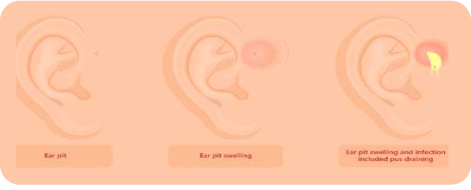









An anaesthetist will see your child before surgery and advise you on the risks of GA.
Some specific risks to the surgery include:
Wound bleeding and infection (less than 1%)
In some cases, a course of oral antibiotics is given post-operation to help prevent infection. If the wound is infected your child may require regular daily dressings until complete healing occurs.
Seroma
While the underlying tissue is healing, there is a potential for fluid to accumulate in the wound, leading to the formation of a seroma. Small seromas usually resolve spontaneously with post-operative wound care, oral antibiotics and pressure dressing.
Recurrence of infection
Even though every attempt is made to remove the preauricular tract completely, there is still a possibility of the infection recurring (less than 2%). This risk is higher if your child has had many infective episodes before surgery, or if surgical removal is attempted during an active infection.
Wound dehiscence/ poor wound healing
Sometimes the wound may fail to heal completely, or it may split open after initial closure. As a result, your child will need daily dressing and wound care for over a week until the wound heals.


Keep the pressure dressing dry for 48 hours after the surgery
Avoid all strenuous physical activities for one week
Consult a doctor if your child experiences the following:
A follow-up appointment is scheduled one week after discharge to check for wound healing. There is no need for the removal of stitches as soluble sutures will be used.